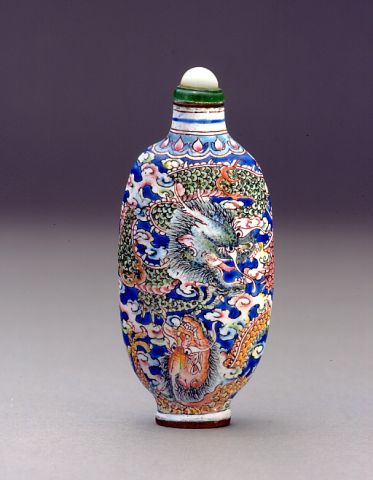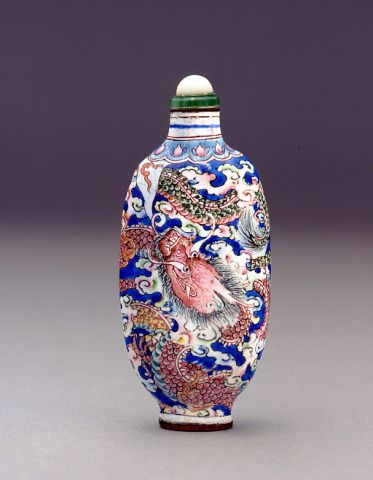

Bottle ID: 00643
GUANGZHOU, FAMILLE ROSE, COILING DRAGONS
Date: 1720-1770
Height: 63 mm
Enamels on copper, of flattened elongated form with rounded shoulders tapering to a straight mouth, and towards the bottom with a slightly splayed base, decorated in famille rose enamels with three scaly coiling dragons flying in and out of scrolling clouds, the white base with a blue enamel flower-head.
Probably Imperial, attributed to the Guangzhou Workshops, Guangzhou.
Similar Examples:
Hughes, Michael C. The Blair Bequest - Chinese Snuff Bottles from the Princeton University Art Museum, 2002, p. 250, no. 349.
Brody, Alexander. Old Wine into Old Bottles: A Collector's Commonplace Book, 1993, pp. 56-57 and p. 151.
Sotheby's, Hong Kong, May 2, 1991, lot 86, The Collection of Arthur Gadsby.
Provenance:
Hugh Moss [HK] Ltd.
Sotheby's, New York, March 27, 2003, lot 347
Ann and John Hamilton Collection, no. 215
Christie's, New York, September 19, 1996, lot 174
Exhibited:
Annual Convention ICSBS Toronto, October 2007
Enamel on metal bottles were being produced in Guangzhou very quickly after the advent of the industry in Beijing. Guangzhou was a thriving commercial port and it was not only trade goods but culture, which was peddled on its streets and in its mansions. The newly rich attempted to acquire the trappings of the established elite in Beijing, and this included snuff bottles of all materials. Enamel on copper bottles provided the elevation in status that the nouveau riche demanded. Snuff bottles were a luxury item, being produced concurrently in the Palace Workshops for the Emperor, his family, and his courtiers. They were also "foreign" and, therefore, sophisticated, as the skill of enameling had been partially developed by the Jesuits at Court, and because the subject matter of European pastoral scenes was depicted upon them.
In addition, it was known that enamel on metal works of art were sent to the Palace for tribute. In 1716, the Governor of Guangdong Province sent to the Imperial Court a group of metal cups on which the patterns were already designed, but which were described as "unpainted and unfired". This can only refer to enamel on copper cups and is an intriguing early eighteenth century reference.
There may even have been an "Imperial" copper workshop based in Guangzhou. Although no documentation exists for this, the Qianlong Emperor had set up jade workshops around the country to supply him with jade works of art, and he may have set up other types of workshops in specific areas, such as Guangzhou.
Between the Kangxi and Jiaqing reigns, at least twenty painters were transfered from Guangzhou to the Palace Workshops. They had to undertake tests to qualify for working, in often unpleasant conditions and for a meagre stipend. If successful, however, the craftsmen could become "Senior Painters". This meant that not only was their long term future secure as enamelers, but also that the emperors would give financial rewards to the best artists. Thus, throughout the Qianlong period, artists from Guangzhou were producing a range of enamel on metal objects, capable of equaling perhaps not the best of the Palace Workshops, but certainly equaling the mid-range output from there.
< Back to full list

 English
English 中文
中文